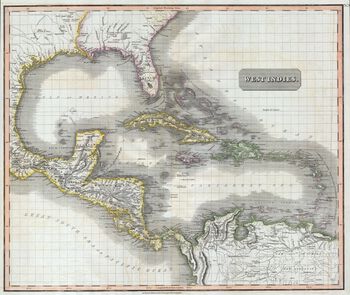قبطانية كوبا العامة
Captaincy General of Cuba Capitanía General de Cuba | |||||||||
|---|---|---|---|---|---|---|---|---|---|
| 1607–1898 | |||||||||
 | |||||||||
| الوضع | Captaincy General | ||||||||
| العاصمة | Havana | ||||||||
| اللغات المشتركة | Spanish | ||||||||
| الدين | Roman Catholicism | ||||||||
| الحكومة | Monarchy | ||||||||
| King | |||||||||
• 1759–1788 | Charles III | ||||||||
• 1886–1898 | Alfonso XIII Maria Christina of Austria (Regent) | ||||||||
| Captain General | |||||||||
• 1764–1779 | Count of Ricla | ||||||||
• 1887–1898 | Ramón Blanco y Erenas | ||||||||
| الحقبة التاريخية | Early modern Europe | ||||||||
• Administrative reorganisation | 1607 | ||||||||
| December 10 1898 | |||||||||
| العملة | Spanish real, Peso | ||||||||
| |||||||||
| اليوم جزء من | |||||||||
جزء من سلسلة عن |
|---|
| تاريخ كوبا |
 |
| محافظة كوبا (1511–1519) |
| نائبية اسبانيا الجديدة (1535–1821) |
| قبطانية كوبا العامة (1607–1898) |
|
|
| الحكم العسكري الأمريكي (1898–1902) |
| جمهورية كوبا (1902–1959) |
|
|
| جمهورية كوبا (1959–) |
|
|
| خط زمني |
|
|
| حسب المواضيع |
The Captaincy General of Cuba (إسپانية: Capitanía General de Cuba) was an administrative district of the Spanish Empire created in 1607 as part of Habsburg Spain's attempt to better defend and administer its Caribbean possessions. It also involved creating captaincies general in Puerto Rico, Guatemala and Yucatán. The restructuring of the Captaincy General in 1764 was the first example of the Bourbon Reforms in America. The changes included adding the provinces of Florida and Louisiana and granting more autonomy to these provinces. This later change was carried out by the Count of Floridablanca under Charles III to strengthen the Spanish position vis-a-vis the British in the Caribbean. A new governor-captain general based in Havana oversaw the administration of the new district. The local governors of the larger Captaincy General had previously been overseen in political and military matters by the president of the Audiencia of Santo Domingo. This audiencia retained oversight of judicial affairs until the establishment of new audiencias in Puerto Príncipe (1800) and Havana (1838). In 1825, as a result of the loss of the mainland possessions, the Spanish government granted the governors-captain generals of Cuba extraordinary powers in matters of administration, justice and the treasury and in the second half of the 19th century gave them the title of Governor General.
History
Antecedents
Since the 16th century the island of Cuba had been under the control of the governor-captain general of Santo Domingo, who was at the same time, president of the audiencia there. He oversaw the local governor and the Santo Domingo Audiencia heard appeals from the island.
See also
- List of colonial governors of Cuba
- Piracy in the Caribbean
- British expedition against Cuba
- History of Cuba
References
Bibliography
- Kuethe, Allan J. (1986). Cuba, 1753–1815: Crown, Military, and Society. Knoxville: University of Tennessee Press. ISBN 0-87049-487-2.
- Pages using gadget WikiMiniAtlas
- Short description matches Wikidata
- Pages using infobox country or infobox former country with the flag caption or type parameters
- Portal-inline template with redlinked portals
- Pages with empty portal template
- Articles containing إسپانية-language text
- Pages using Lang-xx templates
- Coordinates on Wikidata
- Spanish colonial period of Cuba
- Captaincies General of the Spanish Empire
- New Spain
- Spanish West Indies
- Former countries in the Caribbean
- Government of Cuba
- History of New Spain
- 1607 establishments in the Spanish West Indies
- دول وأقاليم تأسست في 1607
- States and territories disestablished in 1898
- 1898 disestablishments in the Spanish West Indies
- 1898 disestablishments in Cuba
- بلدان وأقاليم ناطقة بالإسپانية



